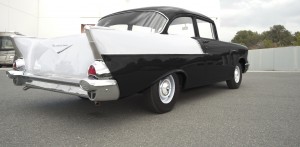Sleeper Alert: “Black Widow” ’57 Chevy 150
How a Parts-Bin Special Became The Most-Feared Competition Car in America
 ”Black Widow.” The name itself struck fear into the hearts of many during the heyday of stock car and drag racing. Born for the 1957 competition year, these unassuming Chevy 150s became the ire of many opponents straight from its inception. The 150s were officially built by SEDCO (the Southern Engineering and Development Company), a subsidiary of Nally Chevrolet of Atlanta. But the company was just a shell for Chevrolet’s factory racing program. If there ever was an example of a factory-bred hare-in-tortoise’s clothing, the Black Widow is it.
”Black Widow.” The name itself struck fear into the hearts of many during the heyday of stock car and drag racing. Born for the 1957 competition year, these unassuming Chevy 150s became the ire of many opponents straight from its inception. The 150s were officially built by SEDCO (the Southern Engineering and Development Company), a subsidiary of Nally Chevrolet of Atlanta. But the company was just a shell for Chevrolet’s factory racing program. If there ever was an example of a factory-bred hare-in-tortoise’s clothing, the Black Widow is it.
To understand how the Black Widow ever came to be, we need to understand racing in 1957. Stock car racing was in its infancy. But it suffered a major blow in 1955. Following a crash at the 24 Heurs du Mans that killed 83 spectators and injured 100 more, the Automobile Manufacturers Association banned factory-backed auto racing and its advertising in America. The ban officially prevented the Big Three from participating in any racing, but by 1957 each manufacturer was attempting to skirt the rules. Chevrolet, for example, set up SEDCO, a shell racing company that appeared to be an independent. Because SEDCO was to remain “independent”, all of the components were shipped to Atlanta to be assembled into race cars with the now-infamous black and white livery.
Black Widows were created entirely from the best off-the-shelf GM parts. Instead of using frames from the Atlanta plant, GM shipped reinforced frames from the Detroit plant. Adding an extra shock to each corner improved stability and six-lug hubs and rear axles added strength for the fuel-injected 283 under the hood. Originally a Bel-Air only option for customers, the F.I. 283 was the first Chevrolet engine to make 1 horsepower per cubic inch. It was an achievement of technology and engineering. A three-speed manual transmission was slotted between the engine and the driveline, and a twenty gallon fuel tank kept the 283 well fed. Meanwhile, Chevrolet shipped the cheapest bodies they could offer – 150 utility sedan models – and left the armrests, ash trays, cigarette lighters and just about anything else for comfort back at the factory. The result was a red-bellied arachnid with a venomous bite.
With its prodigious power reduced weight, the Black Widow ran away with trophy after trophy, including the NASCAR national championship for 1957. To further its success, Chevrolet published the Chevrolet Stock Car Competition Guide, a manual that helped private race car teams build Black Widows around the country. The Black Widow was so successful that its engine, the fuel-injected 283, was banned halfway through the season and the car itself was banned after 1957. Because of its short run, its unofficial creation, and its addition of high-end performance parts, the Black Widow’s official production numbers are unknown. But with so few made, it is clearly one of the rarest Chevrolets ever made. Few cars before or since have evoked such fear and ire as the 1957 Chevy 150 “Black Widow” did in its day.
- February 29, 2012 - FEATURED BUILDS
- February 29, 2012 - Original Equipment Reproduction










